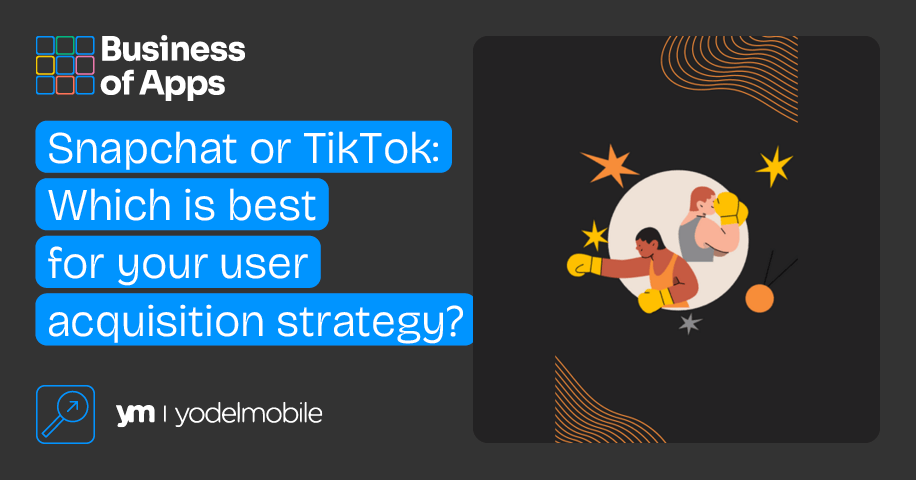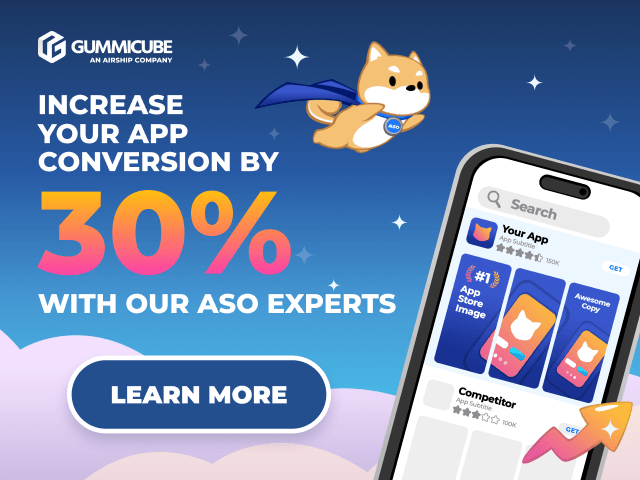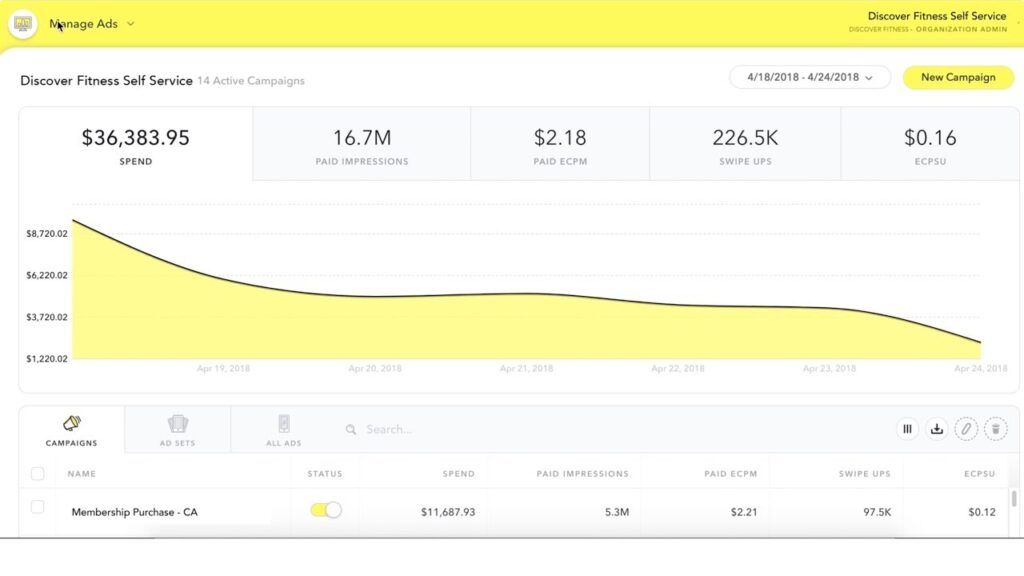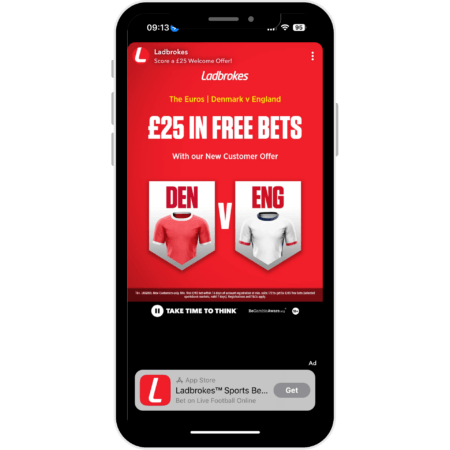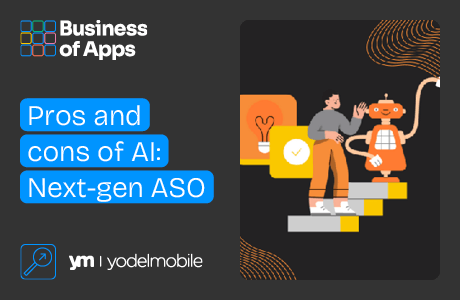Choosing the right platform for your user acquisition strategy can make or break your campaign. With the rise of social media giants like Snapchat and TikTok, businesses and marketers are faced with a crucial decision: which platform offers the best opportunities to attract and engage users?
Does your app rely on a young demographic? Are you looking to expand your audience? Are you looking to acquire new users after launching your app? Then deciding between Snapchat or TikTok can be an important choice.
In this post, we’ll compare the demographics, targeting, engagement and tracking of both platforms and hopefully help you decide which social media channel is better for your app’s marketing campaign.
Snapchat vs. TikTok
There are several factors to consider when deciding which channel is better suited for your paid user acquisition strategy. Pay specific attention to your goals and target audience so that you’re able to make the best possible decision. Both Snapchat and TikTok offer unique opportunities to engage with their users, but the differences they hold in their engagement potential, audience demographics, and their targeting options are what will have a significant impact on the effectiveness of your ad campaigns.
App user demographics
Both platforms, TikTok and Snapchat have varying demographics, each of which will affect the outcome of your ad performance. Let’s start with Snapchat.
Snapchat skews towards younger demographics, with over 70% of its users being under the age of 34. This makes it particularly popular among Millennials and Generation Z.
Snapchat’s global user distribution is extremely diverse. As of April 2024, India had the biggest Snapchat user base in the world, with an audience of 202.51 million users. The United States ranked in second place with over 106 million Snapchat users. The platform continues to grow in other locations, too, such as the Middle East, Latin America, and Southeast Asia, at a remarkable rate. This expansion highlights Snapchat’s efforts to tailor its offerings to diverse cultural preferences, fostering a truly international user community.
What is TikTok’s audience demographics?
TikTok is popular among users within a similar age group, but it skews more towards the older end of the spectrum, with users aged 25-34 accounting for 34% of the platform’s usage.
As of January 2024, the United States had the largest TikTok audience by far, with almost 150 million users engaging with the popular social video platform. Indonesia followed, with around 126 million TikTok users. Brazil came in third, with almost 99 million users.
The determining factors on your side as a marketer will vary based on who you want to attract with your user acquisition strategy. Snapchat excels in reaching youthful and globally diverse demographic, while TikTok will be better suited if your target audience also includes older age groups within 25-34 range.
Mobile ad targeting
An advantage Snapchat may have over TikTok reveals itself in its targeting options.
TikTok paid ads offer three targeting options:
- Demographics
- Interests and behaviours
- Device types
Since 2023, TikTok demographics targeting has consisted of five options: gender, language, age, location, household income, and spending power. Each targeting filter has a more specific range of categorisation options for brands to choose exactly the types of demographics they need.
TikTok interest & behaviour targeting allows advertisers to find your potential customers depending on what they are most interested in and how they interact with TikTok content. The categories include interests, purchase intent, video interactions, creator interactions and hashtag interactions. Behaviour targeting works by showing your content to those watching, liking, commenting, and sharing videos in a particular category.
Among the targeting categories mentioned, ‘high spending power’ targeting is specific to TikTok. This dimension allows to target users who typically spend more on purchases than the average user.
While Snapchat offers similar targeting capabilities, it also offers a unique set of options that allow advertisers to target audiences based on data specific to your business, product, or service. Some of these custom audience options include:
Snapchat Lifestyle Categories: (SLCs) are inferred assignments based on who is most likely to click on ads targeted towards that SLC. SLCs should be used only as a tool for ad targeting and are not indicative of reach to a particular demographic or interest-based category. Data about user preferences relies on inference methodologies, and third-party data sources where applicable, and may be based on inaccurate assumptions.
Snapchat Audience Match: Advertisers can target customers using a list of phone numbers, emails, or device identifiers. Reach out to users who have interacted with your brand before and re-engage them to achieve your goals.
When deciding between Snapchat or TikTok look at how each platform’s behavioural targeting aligns with your audience’s online activities and interests. For example, if you are looking to build brand awareness TikTok’s viral nature might be more effective. For driving conversions with immersive experiences, Snapchat’s advanced targeting and AR features might generate better results.
Ad engagement
With its expected reach of 1.8 billion users by the end of 2024, its algorithm-driven feed and content discovery features, TikTok boasts impressive viral potential. Its impressive engagement rate of 4.25%, makes TikTok one of the most engaging social platforms on the market. According to TikTok statistics, entertainment is its most popular content category, so this might be a useful route to take when considering the style of content to create for your TikTok ads.
Snapchat also maintains impressive ad engagement rates, with Sponsored Lenses leading with an average engagement time of 15-30 seconds per use. Additionally, Snapchat ads showcase high completion rates, contributing to Snapchat’s appeal among advertisers seeking effective and engaging ad placements.
While it may be easy to conclude that TikTok is the more engaging platform for advertising, the choice ultimately depends on the type of advertising experience you want to provide for your users; Snapchat’s best results come from the more personalised and immersive nature of the app, while TikTok prioritises widespread engagement and brand awareness.
The Snap Pixel
Source: Snapchat via YouTube
Ad execution styles
The platform that you use for your advertising campaigns is also dependent on the types of ads that you are trying to run. Different ad styles are beneficial for different types of ads.
TikTok ad formats include:
Branded hashtag ads
These sponsored hashtag challenges are featured on a hashtag results page or the Explore banner. These ads work when a user clicks on the branded hashtag challenge at the top of the Discover Page. Users are then taken to a brand challenge page containing a description of the challenge, rules, the sponsoring brand’s logo and a link to its website. Users then create their content based on the challenge, using the brand’s hashtag to promote their posts.
TopView ads
TopView ads appear immediately after someone opens the TikTok app and can be 60 seconds long. Advertisers can include a call-to-action button within the ad. This ad style probably has a less organic feel to them compared to some other ad formats.
This format can potentially interrupt the user experience. Coupled with their length, TopView ads are among the most “traditional” of TikTok’s video ads because they feel like commercials.
TopView ad example
Source: TikTok
TikTok collection ads
This ad format allows users to find, discover, and browse products on their mobile devices in full-screen mode. These ads effortlessly guide customers to an instant storefront within the app where they can explore your products without ever leaving the platform. This serves as a curated, inspiring collection of your products that users can browse without ever leaving the app. These ads provide a quicker, more engaging ad experience that motivates consumers to act immediately.
You can find a more detailed list of types of TikTok ads here.
Snapchat ad formats include:
Single image or video ads
This is the most common ad format on Snapchat, appearing in users’ feeds, and providing brands with maximum exposure.
Single image or video ad example
Source: Snapchat
Collection ads
Snapchat simplifies the buying process with Collection ads. This format allows you to showcase a list of your products, allowing users to browse and make quick purchases.
Story ads
These ads are integrated into the content as a series of ads and also feature a branded tile in the Discover section. Story Ads offer the advantage of including CTA buttons, which can boost conversion rates.
Overall, where TikTok offers a more diverse range of ad formats, there are also more opportunities for users to engage with an ad. Specifically, branded hashtag challenge ads prompt active user participation, resulting in the generation of more user-generated content, which in turn, can be repurposed for more advertising. Snapchat does offer effective options too, but TikTok’s options are more dynamic in comparison. Again, let your choice of platform be based on your campaign objectives and the types of engagement that you’re looking for.
Story ad example
Source: Snapchat
Evaluating your results: ROI and ROAS
Ultimately, when considering your user acquisition strategy, your primary focus will be maximizing your return on investment (ROI) and return on ad spend (ROAS).
Understandably you may think about your cost efficiency. It’s important to note that advertising costs can vary significantly between TikTok and Snapchat. It’s important you assess the cost efficiency of advertising on each platform in relation to the results that you’ve achieved.
Compare factors such as cost per impression (CPM), cost per click (CPC), and cost per acquisition (CPA) to determine which platform offers the best value for your advertising budget. At an average, you can expect to pay a CPM of $2.95 on Snapchat, while TikTok will charge around $10 for the same.
This does however come with some caveats. The average CTR for TikTok In-Feed ads floats around 1-3%, while Snapchat delivers a CTR of around 0.3-1.5%. While TikTok’s CPM may seem expensive, its average CTR is higher than Snapchat’s. TikTok CPC also comes up relatively cheaper too. You’ll need to weigh up the price of reaching your target audience with the cost-efficient traffic you can drive to your app.
Engagement metrics also provide valuable insights towards the ROI of your advertising efforts. You could look at click-through rates (as mentioned above), video completion rates and interaction rates to assess the effectiveness of your ads on each platform. Look for patterns in user engagement to identify which platform is delivering better results in terms of audience interaction and response to your advertising campaigns.
Also, utilise measurement and analytics tools provided by each platform to track and analyse campaign performance in real-time. You can use TikTok’s TikTok Ad Manager or Mobile Measurement Partners (MMPs) such as Appsflyer, Firebase or Adjust for Snapchat, to monitor key performance indicators (KPIs) such as conversion rates, return on ad spend, and customer lifetime value (LTV) to gauge the overall ROI of your advertising efforts on Snapchat and TikTok.
It is also worth evaluating the growth trajectory and trends of each platform to anticipate future opportunities for ROI. Consider factors such as user adoption rates, platform updates, and emerging content trends that may impact the effectiveness of your advertising efforts. The climate of social media apps is constantly changing and evolving, so it would be best practice to remain engaged with the ways users are responding to each platform.
Evaluating your results
Source: Snapchat for Business
Conclusion
In conclusion, choosing between Snapchat and TikTok for your user acquisition strategy depends on your target audience and marketing goals. Snapchat offers personalised, interactive experiences for a younger audience, while TikTok excels in viral, trend-driven content with broad reach and high engagement.
Snapchat is ideal for brands seeking private, ephemeral interactions, whereas TikTok is perfect for those aiming for widespread visibility and creative video content. Often, a combination of both platforms can provide the best results. By understanding their unique strengths and analysing your campaign performance, you can craft an effective user acquisition strategy that drives your brand’s growth.
If you’re looking to implement a user acquisition strategy tailored specifically to your app, reach out to Yodel Mobile’s team. Their team of app growth experts will support you in delivering campaigns that fit your budget and achieve the highest ROI.



